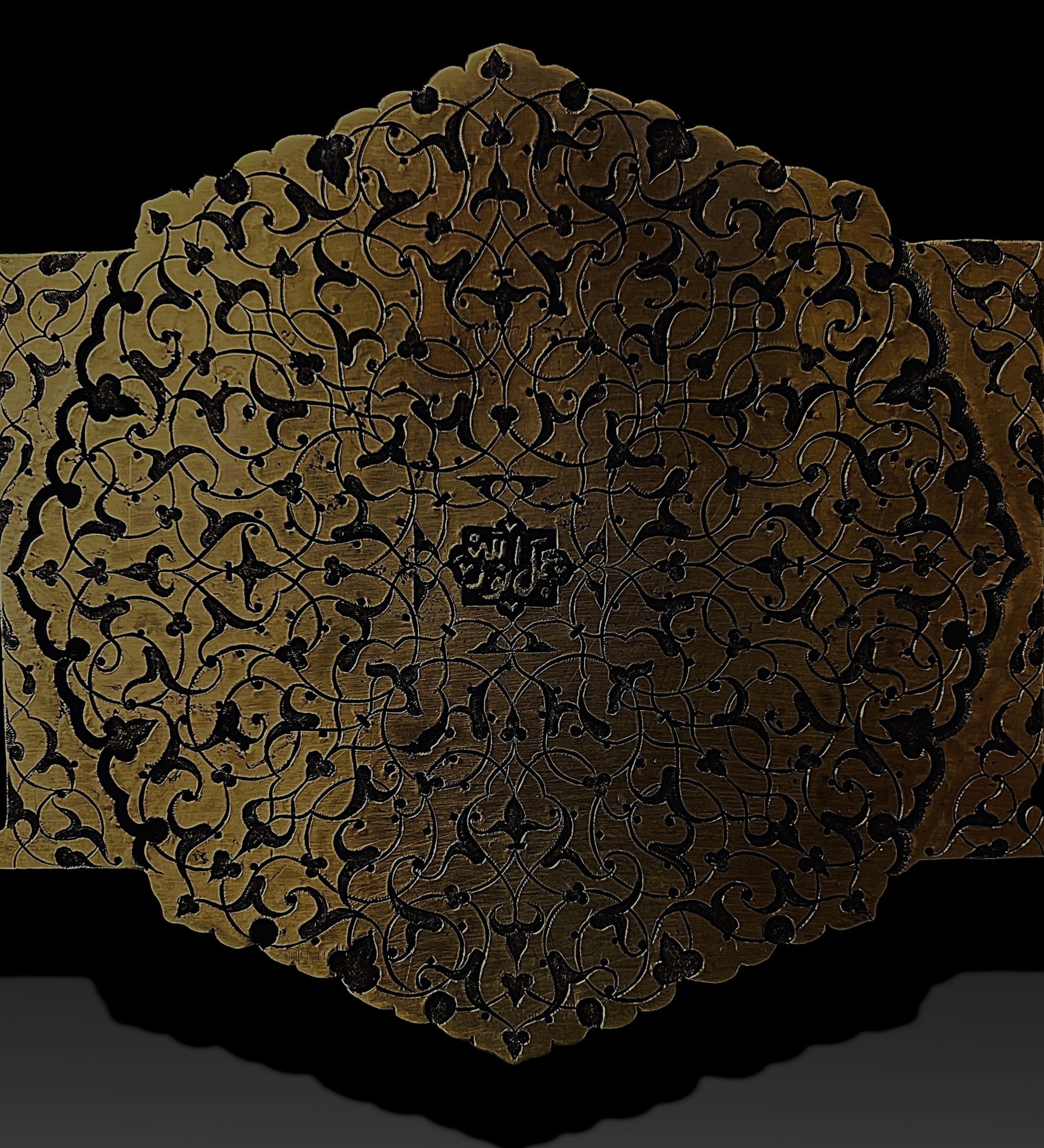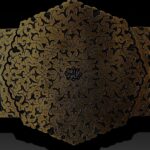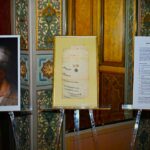AN IMPERIAL DISTINGUSHED ARMBAND FROM SHAH ISMA’IL OF STEEL INLAID WITH GOLD (Maker’s Mark AMAL NUR_AllAH)
PERIOD :
15th Century
ORIGIN:
Ardabil, Aq Qoyunlu
DIMENSIONS:
Large Armband
DESCRIPTION:
AN IMPERIAL DISTINGUSHED ARMBAND FROM SHAH ISMA’IL OF STEEL INLAID WITH GOLD (Maker’s Mark AMAL NUR_AllAH)
This extraordinarily superior armband of (SHAH ISMA’IL) Existed and made early 15th century and Brought in from the city of Tabriz,
Historically it has been articulated to have been taken by (SULTAN SELIM I) thereupon pursuing his triumph at the “Battle of Chaldiran in 1514.
The Armband bearing the name of the maker Nur-Allah.
IMPORTANT NOTE;
We have been advised by our client who has considered admiringly of our collections “NOT” to publicise the addtional pictures due rarity of this particular museum (Object) the copyright and the potential to produce parallel forgery from an image provided.
The conservation of these extraordinarily rare museum composition articles is an integral and privileged part of our clients’ requirements.
FOOTNOTES:
Ismail I (Persian: اسماعیل, romanized: Ismāʿīl; 17 July 1487 – 23 May 1524) was the founder and first shah of Safavid Iran, ruling from 1501 until his death in 1524. His reign is one of the most vital in the history of Iran,[3] and the Safavid era is often considered the beginning of modern Iranian history.Under Ismail, Iran was unified under native rule for the first time since the Islamic conquest of the country eight-and-a-half centuries earlier.
Ismail I (Persian: اسماعیل, romanized: Ismāʿīl; 17 July 1487 – 23 May 1524) was the founder and first shah of Safavid Iran, ruling from 1501 until his death in 1524. His reign is one of the most vital in the history of Iran, and the Safavid era is often considered the beginning of modern Iranian history.Under Ismail, Iran was unified under native rule for the first time since the Islamic conquest of the country eight-and-a-half centuries earlier.
Ismail I
Portrait of Shah Ismail I, painted from life by Kamal al-din Behzad, his director of the royal atelier (posthumous copy). Topkapı Palace Museum,
Shah of Iran
Reign22 December 1501 – 23 May 1524 SuccessorTahmasp I Viziers show See list8th Sheikh of the Safavid orderIn office1494 – 23 May 1524 Preceded by AliMirza Safavid Succeeded by
Tahmasp I,
Born
17 July 1487
Ardabil, Aq Qoyunlu
Died
23 May 1524 (aged 36)
Near Tabriz, Safavid Persia
Burial
Sheikh Safi Shrine Ensemble, Ardabil, Iran
Spouse
Tajlu Khanum
Behruzeh Khanum
Issue
Among others
Tahmasp I
Sam Mirza
Alqas Mirza
Bahram Mirza
Parikhan Khanum
Mahinbanu Khanum
Names
Abu’l-Moẓaffar Ismā’īl ibn Shaykh Ḥaydar ibn Shaykh Junayd
Regnal name
Shah Ismail I
Dynasty
Safavid
Father
Shaykh Haydar
Mother
Halima Begum
Religion
Twelver Shia Islam
Military career
Battles / wars
show
Treelike list
Ismail inherited leadership of the Safavid Sufi order from his brother as a child. His predecessors had transformed the religious order into a military movement supported by the Qizilbash (mainly Turkoman Shiite groups). The Safavids took control of Azerbaijan, and in 1501, Ismail was crowned as shah (king). In the following years, Ismail conquered the rest of Iran and other neighbouring territories. His expansion into Eastern Anatolia brought him into conflict with the Ottoman Empire. In 1514, the Ottomans decisively defeated the Safavids at the Battle of Chaldiran, which brought an end to Ismail’s conquests. Ismail fell into depression and heavy drinking after this defeat and died in 1524. He was succeeded by his eldest son Tahmasp I.
One of Ismail’s first actions was the proclamation of the Twelver denomination of Shia Islam as the official religion of the Safavid state,marking one of the most important turning points in the history of Islam,which had major consequences for the ensuing history of Iran. He caused sectarian tensions in the Middle East when he destroyed the tombs of the Abbasid caliphs, the Sunni Imam Abu Hanifa, and the Sufi Muslim ascetic Abdul Qadir Gilani in 1508.
The dynasty founded by Ismail I would rule for over two centuries, being one of the greatest Iranian empires and at its height being amongst the most powerful empires of its time, ruling all of present-day Iran, the Republic of Azerbaijan, Armenia, most of Georgia, the North Caucasus, and Iraq, as well as parts of modern-day Turkey, Syria, Pakistan, Afghanistan, Uzbekistan, and Turkmenistan It also reasserted persian identity in large parts of Greater persia.
The legacy of the Safavid Empire was also the revival of Iran as an economic stronghold between the East and the West, the establishment of a bureaucratic state, its architectural innovations, and patronage for fine arts.
Ismail I was also a prolific poet who under the pen name Khaṭāʾī (Arabic: خطائي, lit. ’the wrongful’) contributed greatly to the literary development of the Azerbaijani language.He also contributed to Persian literature, though few of his Persian writings survive.
Ismail I was born to Shaykh Haydar and his wife Halima Begum on 17 July 1487, in Ardabil. His father was the sheikh of the Safavid tariqa (Sufi order) and a direct descendant of its Kurdish founder,Safi-ad-Din Ardabili (1252–1334). In 1301, Safi-ad-Din had assumed the leadership of the Zahediyeh, a significant Sufi order in Gilan, from his spiritual master and father-in-law Zahed Gilani. The order was later known as the Safavid. Ismail also proclaimed himself the Mahdi and a reincarnation of Ali. Ismail was the last in this line of hereditary Grand Masters of the order, prior to his founding of a ruling dynasty.
Shāh Ismaʿīl in the Safavid conquest of Shirvan (1501), according to the Shāhnāmah Shāh Ismaʿīl (Tabriz, 1541),a panegyric history he himself commissioned.
His mother Halima Begum was the daughter of Uzun Hasan, the ruler of the Turkoman Aq Qoyunlu dynasty, by his Pontic Greek wife Theodora Megale Komnene, better known as Despina Khatun.Despina Khatun was the daughter of Emperor John IV of Trebizond. She had married Uzun Hassan in a deal to protect the Empire of Trebizond from the Ottoman Turks. Ismail was a great-great-grandson of Emperor Alexios IV of Trebizond and King Alexander I of Georgia.
Roger Savory suggests that Ismail’s family was of Iranian origin, likely from Iranian Kurdistan, and later moved to Azerbaijan where they assimilated into the Turkic-speaking Azeri population.Ismail spoke a Southern Turkic dialect, a precursor of modern Azeri Turkic, in which he wrote his poetry, and also knew Persian.
His ancestry was mixed, consisting in Iranian (likely Kurd) ancestors often intermarrying with Türkmen princesses to form alliances (such as his Aq Qoyunlu mother Halima Begum and paternal grandmother Khadija Begum), supplemented by a mixed Byzantine Greek and Georgian component (from his maternal grandmother Theodora Megale Komnene.
The Safavids were essentially Türkmen of remote Kurdish descent, and the Safavid conquest has been presented as “the third Türkmen wave” to hit persia, after the Seljuks and the Qara Qoyunlu/ Aq Qoyunlu.At the same time, the majority of scholars agree that the resulting empire was an Iranian one.
Battle against the Ottomans
The active recruitment of support for the Safavid cause among the Turcoman tribes of Eastern Anatolia, among tribesmen who were Ottoman subjects, had inevitably placed the neighbouring Ottoman empire and the Safavid state on a collision course.
As the Encyclopædia Iranica states, “As orthodox or Sunni Muslims, the Ottomans had reason to view with alarm the progress of Shīʿī ideas in the territories under their control, but there was also a grave political danger that the Ṣafawīya, if allowed to extend its influence still further, might bring about the transfer of large areas in Asia Minor from Ottoman to Persian allegiance”.
By the early 1510s, Ismail’s rapidly expansionist policies had made the Safavid border in Asia Minor shift even further west. In 1511, there was a widespread pro-Safavid rebellion in southern Anatolia by the Takkalu Qizilbash tribe, known as the Şahkulu Rebellion,and an Ottoman army that was sent in order to put down the rebellion was defeated.
A large-scale incursion into Eastern Anatolia by Safavid ghazis under Nur-Ali Khalifa coincided with the accession of Sultan Selim I in 1512 to the Ottoman throne. Such incursions were one of the reasons for Selim’s decision to invade Safavid Iran two years later.[61] Selim and Ismail had been exchanging a series of belligerent letters prior to the attack. While the Safavid forces were at Chaldiran and planning on how to confront the Ottomans, Mohammad Khan Ustajlu, who served as the governor of Diyarbakır, and Nur-Ali Khalifa, a commander who knew how the Ottomans fought, proposed that they should attack as quickly as possible.
This proposal was rejected by the powerful Qizilbash officer Durmish Khan Shamlu, who rudely said that Mohammad Khan Ustajlu was only interested in the province which he governed. The proposal was rejected by Ismail himself, who said; “I am not a caravan-thief; whatever is decreed by God, will occur.
Selim I eventually defeated Ismail at the Battle of Chaldiran in 1514.Ismail’s army was more mobile, and his soldiers were better prepared, but the Ottomans prevailed in large part due to their efficient modern army and possession of artillery, black powder and muskets. Ismail was wounded and almost captured in battle. Selim entered the persian capital of Tabriz in triumph on September but did not linger.
A mutiny among his troops, fearing a counterattack and entrapment by fresh Safavid forces called in from the interior, forced the triumphant Ottomans to withdraw prematurely.
This allowed Ismail to recover. Among the booty from Tabriz was Ismail’s favorite wife, for whose release the Sultan demanded huge concessions, which were refused. Despite his defeat at the Battle of Chaldiran, Ismail quickly recovered most of his kingdom, from east of Lake Van to the Persian Gulf. However, the Ottomans managed to annex for the first time Eastern Anatolia and parts of Mesopotamia, as well as briefly northwestern persia.
The Venetian ambassador Caterino Zeno describes the events as follows:
The monarch [Selim], seeing the slaughter, began to retreat, and to turn about, and was about to fly, when Sinan, coming to the rescue at the time of need, caused the artillery to be brought up and fired on both the janissaries [sic] and the Persians. The Persian horses hearing the thunder of those infernal machines, scattered and divided themselves over the plain, not obeying their riders’ bite or spur anymore, from the terror they were in … It is certainly said that if it had not been for the artillery, which was terrified in the manner related to the Persian horses which had never before heard such a din, all his forces would have been routed and put to the edge of the sword.
If the Turk had been beaten, the power of Ismail would have become greater than that of Tamerlane, as by the fame alone of such a victory he would have made himself absolute lord of the East.
CONDITION REPORT:
Adequate condition, it is said to have been exchanged with the privileged notable art collectors.
PROVENANCE:
Distinguished Private collections.









